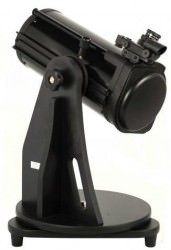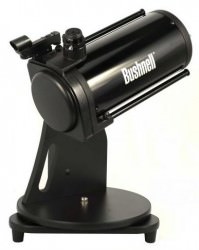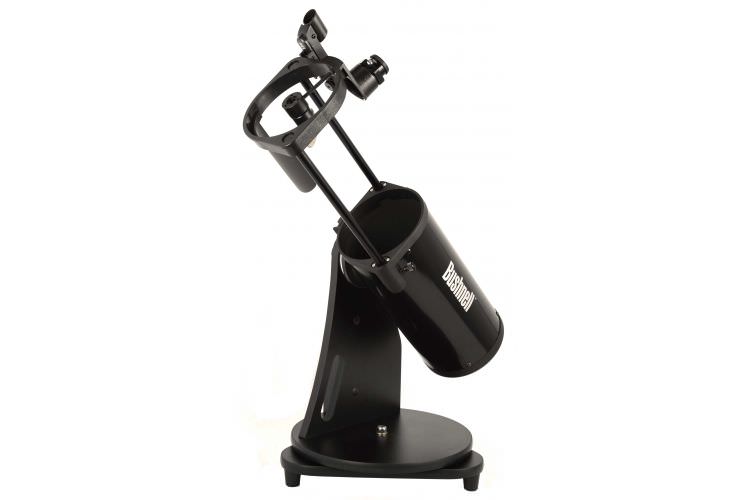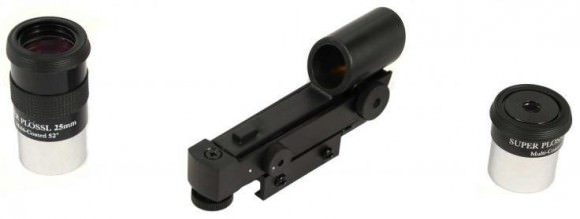[/caption]
Time for me to play with some new equipment? You betcha’. And this time it’s a Bushnell proprietary design – a large, tabletop dobsonian model manufactured specifically for Optics Planet. It’s called the ARES… named for NASA’s Ares rocket… but I think it’s a regular little “lighthouse”!
First let’s start off with some facts and figures. The Bushnell ARES 5″ Truss Tube Dobsonian Telescope 785000 isn’t little. It is a 130mm clear aperture (5″) Newtonian reflector. It has a focal length of 650mm which makes it a sweet f/5. It has a 0.92 arc sec resolving capability and knocks off a very respectable limiting stellar magnitude of 12.7. So how does a lightweight, tabletop dobsonian telescope manage to pull off an f/5 rating when it’s such a compact package? It does what all good telescopes should do… It telescopes! First check out this video…
When I first unpacked the Bushnell ARES, I was pretty upset. It felt like it was going to fall apart in my hands and I was truly worried it had gone through some bad experiences in shipping. But the fault was not in the stars, dear Brutus… It was in my own lack of ability to see exactly how it was put together. My first impression was to tighten down the side bearing to make everything stable – totally overlooking the fact that the telescope’s balance is a long, side-mounted dovetail. Once I realized what I was doing wrong, all systems were then “Go” and it was time to do this little telescope’s magic act and utilize the incorporated truss tubes and slide it up into observing position. My, my… Look at that clean and perfect little ellipsoidal secondary!
 Next step… Attach included red dot finderscope. It goes on its own little metal pedestal and attaches via a dovetail. After that, a quick, cursory collimation check (and a thoughtfully provided center-marked mirror) and make sure everything is snug. When we’re set here, it’s time to take off the dust cover, which I am very happy to say has a slight offset to it which means it opens somewhat like a medicine bottle. This isn’t a dustcap that’s just going to pop off at one good bump. It is heavy duty and was very thoughtfully designed to truly protect the optics tube. Before I put in an eyepiece, however, I’d like to report that there’s nothing cheap about this little dobsonian telescope. Body parts, focuser holder, etc. are metal – not plastic. Friction bearings on the altitude and the azimuth are very positive, and once you’ve balanced the Bushnell ARES, you’ll find its weight to be very positive, secure and even major moves can be made without the assembly bumbling around. The “dobsonian” cabinet is a composite wood with overlay – and it’s actually more of an alt-az arrangement rather than the double side bearings we normally associate with a dob design. However, it is also well-crafted and sturdy.
Next step… Attach included red dot finderscope. It goes on its own little metal pedestal and attaches via a dovetail. After that, a quick, cursory collimation check (and a thoughtfully provided center-marked mirror) and make sure everything is snug. When we’re set here, it’s time to take off the dust cover, which I am very happy to say has a slight offset to it which means it opens somewhat like a medicine bottle. This isn’t a dustcap that’s just going to pop off at one good bump. It is heavy duty and was very thoughtfully designed to truly protect the optics tube. Before I put in an eyepiece, however, I’d like to report that there’s nothing cheap about this little dobsonian telescope. Body parts, focuser holder, etc. are metal – not plastic. Friction bearings on the altitude and the azimuth are very positive, and once you’ve balanced the Bushnell ARES, you’ll find its weight to be very positive, secure and even major moves can be made without the assembly bumbling around. The “dobsonian” cabinet is a composite wood with overlay – and it’s actually more of an alt-az arrangement rather than the double side bearings we normally associate with a dob design. However, it is also well-crafted and sturdy.
OK! So, now we’re down to what else is in the box and putting in an eyepiece for real. The Bushnell ARES 5″ Dobsonian comes equipped with a standard 1.25″ rack and pinion focuser. Here again we’ve got good, standard quality. No “cheapie” parts… Just a solid focuser with a nice firm touch that’s not slopping around with the supplied 25mm Plossl. (Just out of curiousity, I did drop a barlow and a 32mm in it to see what kind of lifting capabilities it had, and I’m happy to report the focuser did just fine.) The focuser also has quite sufficient back focus, so there shouldn’t be any problem with almost any eyepiece you would choose to use. Time for a quick alignment of the red dot finder – which is accomplished with X and Y axis knobs… ones which I will invariably turn instead of turning the finder off and on. However! That’s besides the point. The red dot reflex sight is also good quality, all knobs and adjustments are firm and it has a rolling switch which allows you to adjust the brightness level. (Just don’t do like I have done in the past, and turn it down and forget! The only problem with a red laser dot finder is if your batteries go and you don’t have a spare? That’s it for the night… dig?)
 Where were we? Yes! Yes. The focuser and eyepieces. Here is one thing I will caution you on. The sliding truss tube design of the Bushnell ARES means the truss tubes are slightly lubricated. Just take care not to touch the trusses and then smear an eyepiece or get near that exposed secondary. I realize for an experienced telescope user that you’re going to know that you have something oily on your fingers if you should touch it… and that you’re not going to endanger your optics… but perhaps an inexperienced user or a child just might not have the same savvy. The little Bushnell Dob comes supplied with a 25mm and 10mm Plossl that are also of good quality which don’t want to “unscrew” themselves around the seams and have fold-up rubber eyeguards. Very satisfactory workhorse eyepieces.
Where were we? Yes! Yes. The focuser and eyepieces. Here is one thing I will caution you on. The sliding truss tube design of the Bushnell ARES means the truss tubes are slightly lubricated. Just take care not to touch the trusses and then smear an eyepiece or get near that exposed secondary. I realize for an experienced telescope user that you’re going to know that you have something oily on your fingers if you should touch it… and that you’re not going to endanger your optics… but perhaps an inexperienced user or a child just might not have the same savvy. The little Bushnell Dob comes supplied with a 25mm and 10mm Plossl that are also of good quality which don’t want to “unscrew” themselves around the seams and have fold-up rubber eyeguards. Very satisfactory workhorse eyepieces.
Are you ready? Then let’s put the Bushnell ARES 5″ Truss Tube Dobsonian Telescope through two weeks of star tests…
My first adventures were under dark skies with an average limiting magnitude of 5.5 with seeing a nice, steady 8. I had to see the Andromeda Galaxy… and boy, did I. While the ARES isn’t capable of picking out NGC objects in M31, it delivered all the way across the eyepiece and it’s quite possible to see M32 and M110 with slight to moderate aversion. M33 was very sweet in rich field – there were even hints to the pinwheel spiral structure! M15 was beginning to show signs of resolution even at low power… and the Double Cluster would just knock your socks off. If you want some more fun, then check out M57 and M27 before they’re gone. Just spectacular…
What do I see in deep, wide star fields? There’s a bit of coma at the edges – but I defy you to show me any reflector telescope that doesn’t display some coma. It is simply design inherent and I personally don’t think this telescope displays enough to be distracting and that is that.
The next “star test” is planetary and double stars under LM5/8. Even at the modest magnification the 25mm provides, Jupiter jumps right to life – exhibiting some rusty coloration, limb darkening and the dimensional effect of the Galiean moons. While I am not a fan of high magnification, I did use the 10mm and was pleased again that when this telescope is well-balanced that you can set the friction tension to an absolute minimum and track an object smoothly without disrupting the whole set up. After having viewed Jupiter, it was time to tackle a few favorite double stars, like Kappa Piscium, Gamma Piscium, Gamma Andromeda, Eta Cassiopeia, Alberio and Polaris. They were all fine, clean splits and the Bushnell 5″ ARES dob provides very nice coloration.
The last of my “tests” were a few nights that I got up close and personal with the Moon. (ok, ok… i’m guilty of looking at other things, too.) I’m equally pleased to report that during very steady pockets of seeing that the resolution was very, very nice. While the Bushnell 5″ dobsonian telescope didn’t perform like a 150mm Intes Mak on the Moon, it had absolutely nothing to be ashamed of. Crater edges were crisp and well defined. Limb edges and terminator features were sharp. All in all, it performed very well – even with high magnification!
 So what’s the long and short of the story? If I had to complain about something, I would say it’s the “unsteady” feeling the scope has when the locking mechanism for the sliding dovetail balance is loose. It feels like it’s going to fall off – even though it didn’t and the feeling was only an illusion. The second complaint would just be that you need to be careful around the lubrication on the truss rods. Points in favor? Wow… The Bushnell ARES collapses into a very small, light-weight and very secure portable package. At approximately $150, it might be inexpensive – but it is not cheap. All the parts have been thoughtfully made to work together… and work together for years and years of service. The supplied accessories are of good quality and about the only thing I would suggest is a 1.25″ Moon filter and a collimator (if you don’t already have one). If placed on a tabletop, the assembly is a little hard to aim in some positions because the table gets in the way of the fixed finderscope angle – but it does an awesome job if placed on a stool, wooden cable spool, or even a couple of concrete blocks. Once you’ve found your “comfort zone”, the telescope performs admirably and has enough light-gathering ability to go far beyond the objects that I star-tested. (I know, because I did… and it does.) All, in all the Bushnell ARES is a real “little lighthouse”…
So what’s the long and short of the story? If I had to complain about something, I would say it’s the “unsteady” feeling the scope has when the locking mechanism for the sliding dovetail balance is loose. It feels like it’s going to fall off – even though it didn’t and the feeling was only an illusion. The second complaint would just be that you need to be careful around the lubrication on the truss rods. Points in favor? Wow… The Bushnell ARES collapses into a very small, light-weight and very secure portable package. At approximately $150, it might be inexpensive – but it is not cheap. All the parts have been thoughtfully made to work together… and work together for years and years of service. The supplied accessories are of good quality and about the only thing I would suggest is a 1.25″ Moon filter and a collimator (if you don’t already have one). If placed on a tabletop, the assembly is a little hard to aim in some positions because the table gets in the way of the fixed finderscope angle – but it does an awesome job if placed on a stool, wooden cable spool, or even a couple of concrete blocks. Once you’ve found your “comfort zone”, the telescope performs admirably and has enough light-gathering ability to go far beyond the objects that I star-tested. (I know, because I did… and it does.) All, in all the Bushnell ARES is a real “little lighthouse”…
Or is that a lighthouse “keeper”?
Many thanks go to Optics Planet for being so kind as to trust me with the Bushnell ARES 5″ Truss Tube Dobsonian Telescope 785000 until Ohio skies cooperated long enough to allow me to use it with the time and attention it deserves. This would make an outstanding Christmas present for an older child looking for a quality telescope and an equally fine addition as a worthy “Grab and Go” telescope for the seasoned SkyWatcher.


